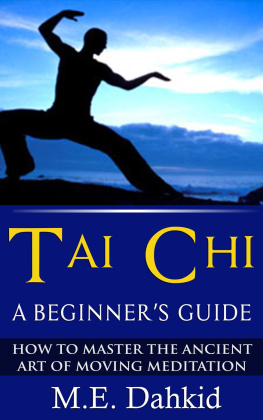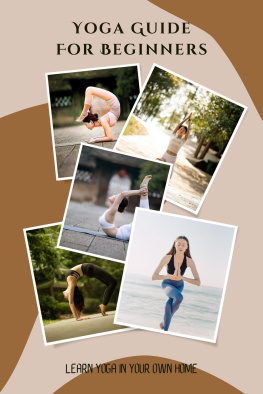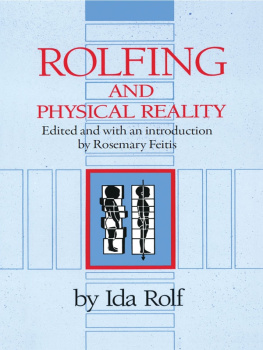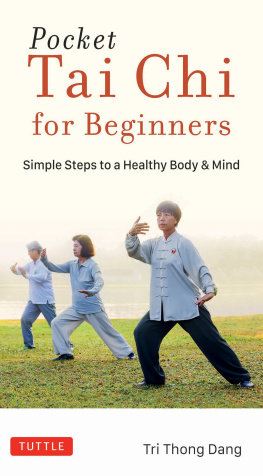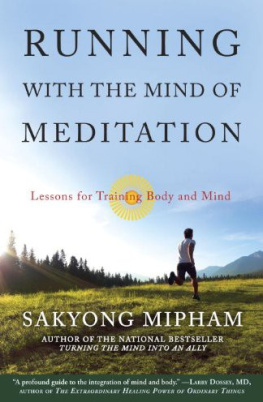Tai Chi: A Beginners Guide
How to Master The Ancient Art of Moving Meditation
Copyright 2016 by M.E. Dahkid
All Rights Reserved. No part of this publication may be reproduced in any form or by any means, including scanning, photocopying, or otherwise without prior written permission of the publisher or copyright owner.
Limits of Liability, Disclaimer of Warranties & Terms of Use
This book is a general educational health-related information product. As an express condition to reading this book, you understand and agree to following terms. The information and advice contained in this book are not intended as a substitute for consulting with a healthcare professional.
The publisher and authors are not responsible for any adverse effects or consequences resulting from the use of any of the suggestions, or procedures discussed in this book. While all attempts have been made to verify information provided in this book, the author and publisher assume no responsibility for errors, omissions, or contrary interpretation of the subject matter herein. All matters pertaining to your physical health should be supervised by a health care professional
Please Leave a Review
Thank you for your purchase
I would be very grateful if you could please leave a review after you have read my book.
That review and feedback will help me to continuously improve the content in my books and make each and every one more relevant and helpful to you.
Thank you again.
M.E. Dahkid
Table of Contents
C hapter 1 The Fundamentals of Tai Chi
Tai Chi (also known as tai chi chuan, meaning great ultimate fist) is essentially a form of Chinese martial art that is characterized by its slow, relaxed movements. It is practiced as both a form of self-defense and a form of relaxation for improving health.
The art of Tai Chi is based on the Yin and Yang, which is a principle of the Chinese that is grounded on the belief that, in nature, two opposing forces can be combined to create harmony. The practice of Tai Chi as a way of improving health is based on the concept of traditional Chinese medicine that diseases result from disturbances in the flow of life energy (chi) and these disturbances are corrected through Tai Chi by redirecting and enhancing the flow of chi.
Tai Chi is believed to have been invented by a wandering Taoist monk named Zhang San-feng in the late 14th or early 15th century. Zhang was a devotee of the martial arts studied them for many years. He developed Tai Chi when he had randomly observed a fight between a snake and a crane. The snake won the fight through the use of relaxed, evasive movements paired with quick counterstrikes. The snakes tactics inspired him to create a fighting form that focused on strength, speed, balance, and flexibility as demonstrated by the snake during the bout with the crane. Since then, Tai Chi evolved through the centuries and became a system of exercises that use slow, soft, relaxed movements. The modern Tai Chi, as commonly practiced today, mainly refers to the series or sequence of slow, coordinated movements that are executed simultaneously in one continuous motion called the form.
Three Treasures
J ust like any Taoist art, Tai Chi practices and techniques work on the three treasures: body, energy, and spirit. Tai Chi works its way through the body first because it is the physical vessel that contains the energy and the spirit. The body refers to Tai Chis physical approach to optimum health, performance, and longevity. Tai Chi exercises the whole body by utilizing the wisdom and understanding on how the body works even in the most subtle aspects. This is because the exercise movements used in Tai Chi are based on the knowledge of the bodys anatomical mechanisms and the relationship and capacity of different parts of the body to work or flow together.
After working on the body, Tai Chi works on the energy. Energy refers to the natural life forces that flow within the body. Tai Chi can increase the bodys life force energy when the Tai Chi of the body and energy is mastered. Along with increasing chi, Tai Chi can smoothen and ground intuitive and psychic capacities, allowing you to control and maintain harmony of the forces that flow within your body.
When achieved on the highest level, Tai Chi can then work on the spirit. The spirit (or mind) refers to the central force or element that directly influences the body and energy. Also known as the highest form of Tai Chi meditation, the spirit utilizes the power of the mind to control the body and the flow of energy to work together harmoniously in whatever way the spirit commands them to move. Working on the spirit is the key to unlocking the gateway to emotional balance, personal power, inner peace, and higher potentials of the mind.
Benefits of Tai Chi
T he practice of Tai Chi provides many benefits to the human body. Aside from the physical benefits, the practice of Tai Chi can bring improvements in different aspects:
Challenge Learning to master Tai Chi challenges your physical and mental capabilities. Tai Chi requires effort, patience, and discipline.
Improved coordination Tai Chi progressively improves your gross physical coordination and even the most subtle aspects of physical movement. It utilizes integrated whole-body movements, so it compels your body to move different parts at the same time with smoothness, correct speed, and harmony.
Better balance Tai Chi movements compel your body to keep its balance as you move body parts in one flow. It is not easy to stay firmly grounded as you execute different movements simultaneously, so the constant practice of Tai Chi enhances your sense of physical balance.
Develops confidence Tai Chi movements involve the execution of different coordinated body movements, which could be difficult to attain if you feel awkward or unsure of your physical capabilities. In order to fully understand and master the moves and forms, you must feel empowered and confident that you can execute each move smoothly.
Relaxation Tai Chi is a relaxing art. It reduces physical stress and fatigue by improving your bodys blood and energy circulation, making you feel calm and relaxed with every movement.
Increased strength Although Tai Chi is not an intense or explosive exercise, it effectively improves physical strength by exercising the muscles through tonic exercises that cause the muscles to contract and relax in a sequenced pattern. That continuous contraction and relaxation pattern causes the muscle tone to improve, thus enhancing your muscle strength and power.
Chapter 2 Tai Chi Styles and Forms
Styles
J ust like any art, Tai Chi also has different major schools that are named after their founding families or lineage. Each school teaches its own distinctive styles and techniques in Tai Chi. Though they teach the same movements, the execution is slightly or subtly different in every style.
There are five major schools of Tai Chi, but only four of them are founded by major Tai Chi families that established their own stylesChen, Yang, Wu, and Hao. The fifth, which is the Combination styles, can be likened to a dances freestyle techniques.
The Chen style is distinctly characterized by slow and explosive movements that are executed in an alternating pattern. The Chen is the first known Tai Chi style and also the most complex. Beginners may find the Chen style to be difficult because it already requires smooth physical coordination right at the beginning. It originated from the Chen village in China in about 17th century. It was a mysterious style that the Chen villagers used in defending against bandits and warlords. The silk reeling energy is a trademark technique of the Chen style which uses external coiling movements to unravel a silk worms cocoon with smooth circular motion of the hands while exerting continuous pressure.
Next page
